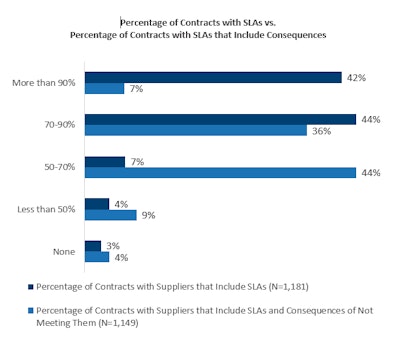
A service level agreement (SLA) defines the specifications, quality and cost of a good or service being provided by a supplier to a buyer. SLAs help to provide transparency about what the buyer expects from the supplier and protects all parties in the event of a dispute or a disagreement.
Ideally, SLAs should include rewards and incentives for meeting expectations, but even more importantly, they should clearly specify the consequences that the supplier will face if the terms of the SLA are not met. Some common consequences for failure to meet an SLA include:
- financial penalties,
- a lower price per item for the supplier,
- the loss of preferred seller status, or
- the termination of the business relationship (in extreme situations).
In the absence of any documented consequences, organizations can only rely on the supplier’s desire to receive any performance incentives that may be in the contract. If these are absent, then the buyer can only rely on the supplier’s integrity and goodwill. That level of trust may be high enough in cases where the buyer and the supplier have a strategic, mutually beneficial relationship with each other, but in more transactional relationships, the absence of consequences can make an SLA effectively toothless.
Many Organizations are missing Consequences in their SLAs
Many organizations are doing a good job including SLAs in their contracts with suppliers and service providers. APQC finds that 86% of surveyed organizations have contracts that include an SLA for 70% or more of their suppliers. Only 14% of organizations have SLAs for half or fewer of their suppliers.
However, just having the SLA in place is not enough. We found that many organizations still have opportunities to include the consequences of not meeting the SLA expectations in their contracts with suppliers. Just seven percent of organizations include consequences for more than 90% of their contracts, while slightly more than a third (36%) include consequences in 70 to 90% of their contracts (Figure 1).
 Fig. 1, APQC
Fig. 1, APQC
Finding the Right Consequences is a Balancing Act
Consequences create clarity by providing an opportunity for buyers to plainly state their expectations and what’s at stake when they are missed. When these expectations are not visible, suppliers are left to guess which elements of the contract are the most critical. If they find themselves in a scenario where there are multiple elements in the contract that may go unfulfilled, suppliers may focus on optimizing or meeting requirements that are less important to the buyer, but easier to achieve.
While consequences are important for an SLA, formulating the right consequences is a balancing act. You want to be clear, but also avoid being too heavy handed. For example, organizations committed to social procurement (that is, driving positive social change through procurement spending) could be working against that goal if SLA consequences include heavy fines and onerous penalties for a supplier from a historically underrepresented group. If working with smaller and more diverse suppliers is a value, you’ll want to take that into account and make sure you don’t prevent them from doing business with you because your terms are too punitive.
Striking the right balance can be a challenge, especially since there is no one-size-fits-all set of consequences that apply to every SLA. Effective penalties will vary from one contract and one relationship to another, which means you’ll need at least some knowledge of your supplier’s culture and priorities to design consequences that are effective and that make sense for the relationship.
As you work to strike the right balance for penalties, don’t forget to include rewards for meeting or exceeding SLA targets. Rewards could mean achieving or maintaining preferred seller status, getting a higher share of the buyer’s spend in the future or getting a monetary bonus in addition to the contract payment.
Key Takeaways
Why should your supplier comply with the terms of the SLA they signed with you? “Because I said so” is not a good enough answer, but SLAs that do not specify any penalties effectively amount to this toothless answer. Consequences are important for setting clear expectations about what is at stake in your agreement. At the same time, it’s important to moderate your consequences in line with the supplier and the nature of your relationship with them. A well-balanced set of incentives and consequences will help to clarify expected performance without pushing your suppliers away.




























